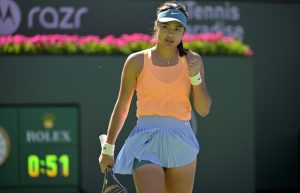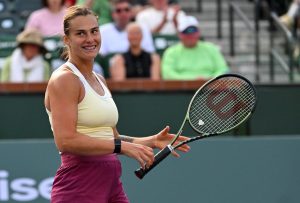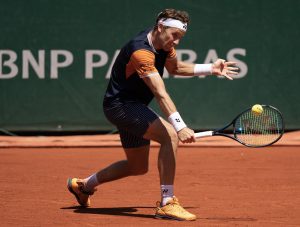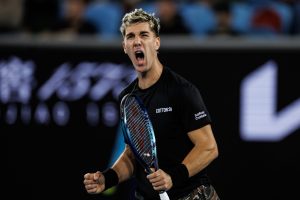As tennis finally enters its all too brief off-season, our resident tennis historian, Martin Keady, looks back at some of the highlights of the 2018 season.
If 2017 felt a little like 2007, at least on the men’s side as Roger Federer and Rafael Nadal shared the year’s Majors between them, 2018 felt a little like…well, 2008, the year in which Novak Djokovic won his first Major and first showed he could break the Federer-Nadal duopoly. Indeed, Djokovic’s comeback this year, in which he won the Wimbledon and US Open and almost went unbeaten for the entire second half of the season, was arguably even more impressive than those of Federer and Nadal the year before.
There were no such feelings of déjà vu in women’s tennis, as there were four different winners of this year’s Majors, three of them by first-time Major winners. As Serena Williams struggles to regain her previous supremacy of the women’s game after giving birth, the women’s game is thrillingly unpredictable and perhaps more genuinely open than at any time since the start of the Open Era half a century ago.
Here are 10 terrific things from tennis in 2018.
- CAROLINE WOZNIACKI FINALLY WINS A MAJOR
It had been feared that Caroline Wozniacki might become another Dinara Safina or Jelena Janković, a World No.1 who never won the Major that would legitimise that ranking. Like Safina and Janković, she had reached Grand Slam Finals before (she was runner-up at the US Open in 2009 and 2014), but she had never produced her best form in one. However, all that changed at the Australian Open this year.
Her opponent in the Australian Open Final was Simona Halep, another prodigious talent trying to get the Major monkey off her back, and between them they produced a classic that, in the searing Australian heat, ultimately left Halep hospitalised. Fortunately, she recovered sufficiently to win her own first Major in Paris in the spring.
For Wozniacki, the moment of triumph that she had waited so long for finally arrived in Melbourne, and both the tennis world (which had long recognised her great talent and even greater fighting spirit) and the wider world (which had been shocked and appalled by Rory McIlroy’s very public rejection of her after they had sent out their wedding invitations) rejoiced with her.
- ROGER FEDERER WINS A 20TH MAJOR
For Wozniacki, the Australian Open 2018 was her first Slam; for Roger Federer, it was his 20th. In the process, he generated perhaps the single-most stunning tennis statistic (tennistic?) of the year, namely that in the 50 years since tennis had become fully professional he had won 10% of all the men’s Majors played in that time. It was a stat that marked both the sport’s remarkable progression since 1968 (from a largely amateur sport that lacked the profile of other major individual sports such as golf and boxing to undoubtedly the greatest individual sport in the world) and Federer’s own singular contribution to that progression.
At the end of 2018, however, it increasingly appears that Federer’s stellar start to the year may just have been his last hurrah on the Grand Slam stage. Unlike in 2017, when he won two Majors (the Australian Open and Wimbledon) and played for the first six months of it arguably the best tennis that he or any other man has ever produced, for the rest of 2018 he never reached the heights he had scaled in Melbourne. He did become the oldest ever World No.1 after winning in Rotterdam in February, but thereafter he lost to Kevin Anderson in the quarterfinal at Wimbledon (after being two sets up) and then, even more surprisingly, to Australian journeyman John Millman in the US Open.
Toni Nadal, Rafa’s uncle and former coach, has already gone on record as saying that he does not believe that Federer will win another Major, and his is obviously an expert (if not exactly unbiased) opinion. Federer has certainly been written off before, especially during the near five-year Major drought that he experienced between winning Wimbledon in 2012 and triumphing in Melbourne in 2017. However, he knows that he now faces a double threat to his status, not only from the other members of the great “trivalry” of tennis (Nadal and Djokovic) but from the younger players (such as Alexander Zverev and Borna Coric) who are finally beginning to show potential Major-winning form.
- THE EMERGENCE OF KYLE EDMUND
The third of the hat-trick of delights from this year’s Australian Open was not as universally hailed or celebrated as the victories of Wozniacki and Federer, but for British tennis fans it was actually far more important. It was the run to the semi-final of Kyle Edmund, which finally gave those fans hope that there might just be cause for hope after Andy Murray, who spent almost the whole of 2018 trying to recover from hip surgery.
Edmund’s biggest scalp on the way to the semi-final in Melbourne was Grigor Dimitrov, the brilliant Bulgarian who for so long had seemed the natural successor to Federer, Nadal and Djokovic at the top of the men’s game. Indeed, when Dimitrov won the ATP Tour Finals at the end of 2017, which was easily the biggest tournament win of his career, he seemed set fair to at last make a meaningful challenge at the Majors in 2018. Unfortunately for him, Edmund’s biggest weapon, his mighty forehand, blasted him off court in four sets in their last eight clash.
At the end of 2018, Edmund actually has a higher ranking than Dimitrov (14 to Dimitrov’s 19), which few people would have foreseen at the start of the year. Although he could not replicate his Australian form at the year’s other Majors, he still rose steadily up the rankings, such that at one point he even entertained hopes of making the ATP Tour Finals. He didn’t quite manage that, but before injury curtailed his season he did win his debut ATP title, the European Open in Antwerp, coming from a set down to beat Gael Monfils in two successive tie-breaks. As he broke down in tears afterwards, rather like Murray had done after the 2012 Wimbledon Final that he lost to Roger Federer, it was obvious that British tennis had a new and engaging star.
- JUAN MARTÍN DEL POTRO FINALLY WINS A MASTERS TITLE
Such has been the incredible success of “The Big Three” in men’s tennis that Argentina’s giant (of tennis ability as well as stature), Juan Martín del Potro, had never won an ATP Masters 1000 title before this year. He had won a Major (the 2009 US Open) and the Davis Cup for Argentina (in his great comeback year of 2016), but the domination of the men above him in the world rankings, coupled with his own disastrous and near decade-long run of injuries, had prevented him from ever winning one of the tournaments that are ranked only below the Majors. However, at Indian Wells in March he finally rectified that.
Rather like Caroline Wozniacki’s debut Majors win, del Potro’s debut Masters victory must have been all the sweeter as it came after a truly epic contest. In fact, del Potro’s opponent in the Indian Wells Final, Roger Federer, actually had three championship points, before del Potro finally won the title in a third set tie-break.
Later in the year, Del Potro reached a second US Open Final, which he lost against a resurgent Novak Djokovic. Nevertheless, his maiden Masters win at Indian Wells was another significant success to put alongside his US Open victory, Davis Cup triumph (the first in Argentina’s long history as a tennis nation) and Silver Medal in the Singles at the Olympics in 2016. For a man who has seemingly spent more of his career in rehab than on the court, that is an extremely impressive list of achievements.
- THE EMERGENCE OF DARIA KASATKINA
Daria Kasatkina was not exactly unknown before 2018 (she had already won a WTA title at Charleston in 2017). However, there is no doubt that her performance at the French Open in 2018, where she reached the last eight, introduced the young Russian to a much wider audience. And what that audience saw, it loved.
The reason that Kasatkina is so special is that in 21st century tennis, in which the default setting for both men and women is to hit the ball as hard as they can, she is the rarest of rarities, an almost “old school” player who manipulates the ball, with swerve and spin, as much as she simply hits it. At Roland Garros in May, she exhibited her full repertoire of dices and slices, especially in her fourth round demolition of Caroline Wozniacki, who had just won her first Major in Melbourne.
Unfortunately for Kasatkina, she got nowhere near that standard of play in her quarterfinal against Sloane Stephens, which she lost meekly in straight sets. Even more worryingly, that match confirmed the suspicion that she has every shot in her armoury except the most important one – the serve. At times against Stephens, her serve barely crept over the net.
Clearly Kasatkina needs to work on her serve more than any other part of the game and even if she cannot turn it into a “weapon”, as such, she can still immeasurably improve it. Quite simply, she needs a specialist serving coach and if she can find one she might just follow in the footsteps of other great tennis artists, such as Miloslav Mečíř and Nicola Pietrangeli, and compete in Major semi-finals and finals.
- MARCO TRUNGELLITI PROVES HE IS THE LUCKIEST (AND PLUCKIEST) OF LOSERS
In any review of the tennis year, it is easy just to focus on the Major winners and the major stories. However, that would be to overlook some of the smaller, less obviously important characters and stories who nevertheless contributed so much to tennis fans’ enjoyment throughout the season. And in that respect, one of the greatest tennis stories of 2018 was that of Marco Trungelliti and his genuinely epic journey to the French Open.
Trungelliti is probably the journeyman’s journeyman, but it was the actual journey that he undertook from Barcelona to Paris that captured so many people’s imagination. When Nick Kyrgios pulled out of the French Open at the last minute with a sore elbow, Trungelliti, who had already lost in the qualifiers a few days before, was offered his place as a “lucky loser”. The only problem was that he had already returned to his home in Barcelona and had to reach Paris ASAP.
Cue the kind of chaos and confusion that is almost crying out to be turned into a road movie (a kind of sporting equivalent of The Daytrippers). Trungelliti loaded his entire family, including his grandmother who he had to summon from the shower, into his car and they drove from Barcelona to Paris in ten hours. Even more astonishingly, he not only made his first match but won it, against Australia’s Bernard Tomic, a player with all the talent that Trungelliti lacks but seemingly none of the Argentine’s character. And although he lost in the second round, the story of how he had made it to Paris in the first place was a reminder that every dog, and even every journeyman, has his day.
- THE DJOKOVIC-NADAL WIMBLEDON SEMI-FINAL
Obviously, as at every other tournament there were two semi-finals at Wimbledon this year. One changed tennis, or at least Wimbledon, history, as the extraordinary contest between Kevin Anderson and John Isner, which Anderson finally won 26-24 in the fifth, eventually led to Wimbledon introducing a fifth set tie-break at 12 games all. The second semi-final, between Novak Djokovic and Rafael Nadal, was largely overlooked in the wake of the first, but that is unfair, as it may just have been the best men’s match of the year.
It is easy now at the end of the season, the second half of which Djokovic has completely dominated, to forget exactly where his game was in the summer, namely the dumpster. He had just lost a French Open quarterfinal to Italy’s little-known Marco Cecchinato and in the press conference afterwards he suggested that he might miss the grass season altogether. He recanted and competed at Queen’s, but even when he had a Championship point against Marin Cilic in the final he somehow still managed to lose. It appeared that “the bad Novak” – the one whose form had fallen off a cliff-edge since he won the career Grand Slam at the French Open in 2016, which also meant that he held all four Majors at the same time, something that neither Federer nor Nadal has ever achieved – was here to stay.
Then came Wimbledon and more specifically the semi-final against Nadal, who had just won his 11th French Open. Controversially, it started late in the day, after Anderson-Isner’s match was finally completed. However, it was more than worth the wait, as the two great men traded sets until the fifth, which actually had to be completed the following day. Then, the level of tennis went up yet another notch, to the point that it evoked memories of their magnificent Major Finals at the US Open in 2011 and the Australian Open in 2012 (both of which Djokovic won). Finally, the Serb triumphed 10-8 in the fifth. He easily defeated a still-exhausted Anderson in the Final and “the good Novak”, the one who many experienced tennis observers (including Nick Bolletieri) regard as the best all-round male tennis player ever, was finally back.
- NAOMI OSAKA’S US OPEN WIN
Sadly, Naomi Osaka was denied her actual moment of triumph in New York, because of all the brouhaha surrounding Serena Williams’s pathetic squabbling with the umpire, Carlos Ramos, over the supposed “coaching” she was receiving from Patrick Mouratoglou in the stands. Nevertheless, Osaka’s maiden Major win signalled the arrival of a truly major new talent in the women’s game.
Osaka’s origins are intriguing. She was born in Japan and still identifies as Japanese, but she has lived in the USA since she was a small child and it is that “Asian-American” status that has made the game’s marketers and promoters so interested in her. She could yet develop into the “poster girl” that women’s tennis will need after Serena finally retires, and as such she could be instrumental in increasing the popularity of tennis even further, especially in Asia and America.
That said, it is her game that is the most important thing about Osaka. Despite the painful ending to her first Grand Slam Final, it was appropriate that she had faced Serena, as she seems to be the best example of the kind of “post-Serena” player that is emerging in Williams’s wake. Along with the likes of Garbiñe Muguruza and Jelena Ostapenko, she has the power game, with a big serve and almost equally big groundstrokes, that Serena and her sister Venus virtually invented.
The challenge for Osaka is to avoid the traps (instant celebrity and the subsequent slow erosion of form) that have dogged Muguruza and Ostapenko since their debut Major victories, and to go on and win multiple Majors. Ironically, the fact that she was denied her moment of triumph after her first Major victory might just spur her on to win more Majors in the future.
- ALEXANDER ZVEREV’S VICTORY AT THE ATP TOUR FINALS
Grigor Dimitrov’s inability in 2018 to build on his triumph at the 2017 ATP Tour Finals should serve as a cautionary tale to Alexander Zverev, his successor as champion at the men’s season-ending tournament. Having said that, there is every chance that Zverev, who is six years younger than Dimitrov, will be able to use the biggest victory of his career so far as a springboard to even greater achievements, in a way that so far has proved impossible for Dimitrov.
What was so striking about Zverev’s win in London earlier this month was the nature of the opposition that he overcame, both on and off the court. On the court, he not only defeated Roger Federer in the semi-final and Novak Djokovic in the final, but he defeated Djokovic after being almost swept off court by the Serb in their group stage meeting. Clearly, Zverev is a fast learner, as he maintained his intensity in the final against Djokovic in a way that he had been unable to in their first meeting.
Off the court too, Zverev impressed hugely, especially in his response to the furore surrounding his semi-final defeat of Federer. Zverev was entirely within his rights to stop play when a ball boy dropped a ball during play; indeed, he may have done so to prevent Federer, towards whom the stray ball was travelling, from injuring himself. Nevertheless, that was not enough to prevent the most foolish “Fed-Heds” present from booing him both during and after the match.
Even though he had no need to, Zverev apologised afterwards for the controversy and that level-headed, almost self-deprecating approach seemed to be further evidence of the maturity that he is increasingly showing. It is that new-found maturity, as much as his much-improved serve and magnificent all-court ability, that could just propel him to the top of the men’s game in 2019.
- CROATIA (AND MARIN CILIC) WIN THE DAVIS CUP
The final highlight of 2018 came right at the end of the season, in the final tournament, in which Croatia defeated France to win the Davis Cup, the last one to be played in its century-old format before the dramatic changes to the tournament next year. And rather like Zverev in London a week earlier, what was so impressive about Croatia’s main man, Marin Cilic, was his behaviour both on and off court.
In an interview during the weekend he acknowledged how hard it must have been for the French team to play at home, in front of an expectant crowd, as he had experienced exactly the same pressure in 2016, when Croatia faced Argentina in the Davis Cup Final in Zagreb. Then, Cilic had played in the doubles as well as two singles matches, and although he won his first singles match and the doubles match alongside Ivan Dodig, the strain of such ceaseless competition in such a short period of time ended up taking its toll. He eventually lost a quite magnificent second singles match to Juan Martín del Potro in the fifth set, having won the first two sets.
Last weekend, Cilic showed how much he had learned from his miserable end to the 2016 Davis Cup Final. He played quite beautifully in his two singles matches, beating Jo-Wilfried Tsonga in the first and Lucas Pouille in the second, winning both in straight sets. Most importantly, however, he sensibly skipped the doubles (which Croatia lost) to save his energy for the deciding second singles rubber on the Sunday. Although giants of the game such as Boris Becker and Andy Murray have managed to win the Davis Cup virtually on their own, by competing in two singles matches and the doubles, either Cilic or the Croatia captain, Željko Krajan, sensibly realised that in this instance less truly was more, and so Cilic just competed in the singles.
The result was that Croatia won what may yet prove to be the last ever Davis Cup, which is a possibility given the competition between the revamped Davis Cup and the newly created ATP Cup. In the process, Cilic achieved a superb double, having won not only one of the greatest prizes in individual tennis (the 2014 US Open) but the very greatest prize in men’s team tennis.
Next week: 10 TERRIBLE Things In Tennis in 2019.
Main Photo:






